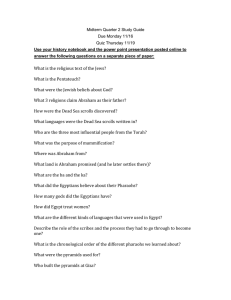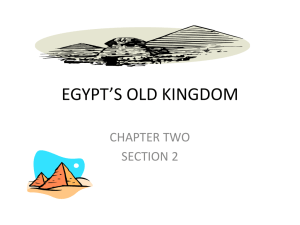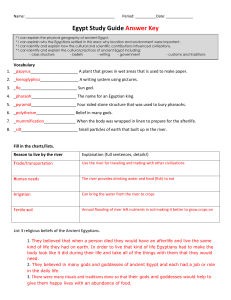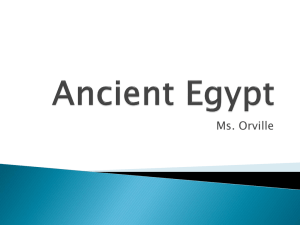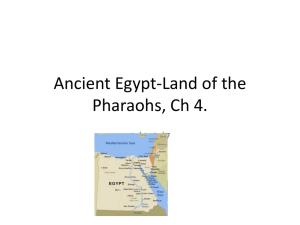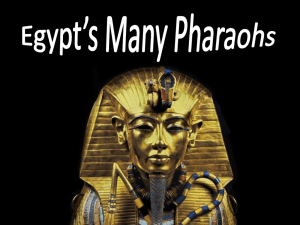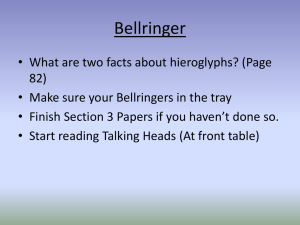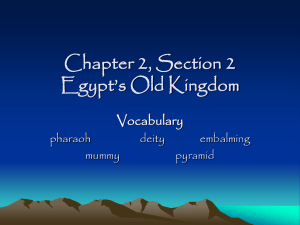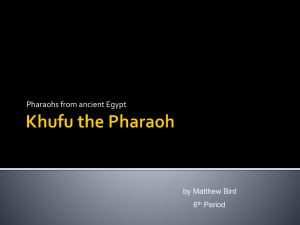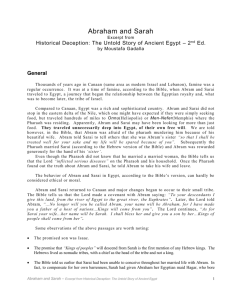Use your history notebook and the power point presentation posted
advertisement
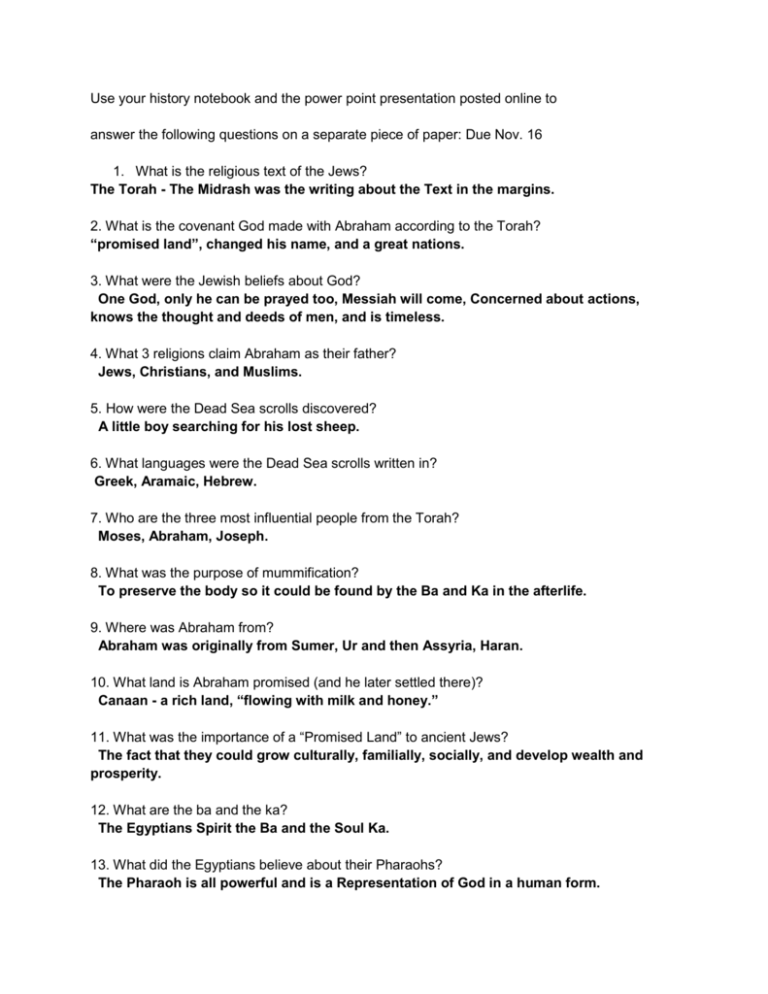
Use your history notebook and the power point presentation posted online to answer the following questions on a separate piece of paper: Due Nov. 16 1. What is the religious text of the Jews? The Torah - The Midrash was the writing about the Text in the margins. 2. What is the covenant God made with Abraham according to the Torah? “promised land”, changed his name, and a great nations. 3. What were the Jewish beliefs about God? One God, only he can be prayed too, Messiah will come, Concerned about actions, knows the thought and deeds of men, and is timeless. 4. What 3 religions claim Abraham as their father? Jews, Christians, and Muslims. 5. How were the Dead Sea scrolls discovered? A little boy searching for his lost sheep. 6. What languages were the Dead Sea scrolls written in? Greek, Aramaic, Hebrew. 7. Who are the three most influential people from the Torah? Moses, Abraham, Joseph. 8. What was the purpose of mummification? To preserve the body so it could be found by the Ba and Ka in the afterlife. 9. Where was Abraham from? Abraham was originally from Sumer, Ur and then Assyria, Haran. 10. What land is Abraham promised (and he later settled there)? Canaan - a rich land, “flowing with milk and honey.” 11. What was the importance of a “Promised Land” to ancient Jews? The fact that they could grow culturally, familially, socially, and develop wealth and prosperity. 12. What are the ba and the ka? The Egyptians Spirit the Ba and the Soul Ka. 13. What did the Egyptians believe about their Pharaohs? The Pharaoh is all powerful and is a Representation of God in a human form. 14. How many gods did the Egyptians have? The Egyptians had over 1000 Gods. 15. How did Egypt treat women? Women in Ancient Egypt had way more rights than in other ancient cultures. Almost the same rights as men. Couldn’t go to school but hey could own property, divorce their husbands, and were an important part of the court. 16. How many female Pharaohs were there? Three Pharaohs the most powerful was Hatshepsut and she was a real pharaoh who increased trade and grew the empire. She was also known to dress as if she were a man to help solidify her reign. 17. What are the different kinds of languages that were used in Egypt? Hieroglyphics, demotic, and greek. 18. Describe the role of the scribes and the process they had to go through to become scribes? Forth in social class. Women could go to school to be a scribe but not become a scribe. Scribes had an important role as the historians and record keepers. They went to school to learn to write information and contracts. 19. What were the pyramids used for? Pharaohs and loot. 20. Who built the pyramids at Giza? Djozer, Imhotep (Architect), Kufu, kafre 21. What is the most Important fact about King Tut? He had a complete undisturbed tomb. Because of his tomb we know more about pharaoh's tombs and the wealth of the egyptian pharaohs. 22. How long did it take to mummify someone? 70 days. 23. Compare and contrast Buddhism, Hinduism, Judaism and the Egyptian religion. View of God Buddhism Hinduism Judaism Egyptian many gods, no supreme god. many gods, no supreme god. one God, you pray only to him. He is all knowing and many gods, prayed to pharaoh unchanging Afterlife reincarnation Many levels of progression Nirvana Reincarnation Dharma Kharma Heaven Hell Action determine where you go. Mummification Weighing of the heart. Teachings (do on your own) (do on your own) (do on your own) (do on your own) 24. What were each of their beliefs about the afterlife, their view of “god(s)” and basic things they taught their people? see above. 25. What is the difference between upper Egypt and lower Egypt? Upper egypt higher in elevation, all the mines and gold, natural resources, close to the mountains. Lower egypt the flood plane most of the major cities and where the crops come from. 25. Compare and Contrast the caste system of India to the social structure of Egypt. 26. What were some similarities and difference? Done in class 27. What is the Abrahamic Covenant and why is it relevant today? Was a covenant/promise/deal between God and Abraham that talked about a promised land and blessing his posterity. It’s important because the idea of a promise land comes from here and that is what the pilgrims were looking for when they sailed to America. 28. What type of government (from the types of government we talked about from Aristotle) did China, Mesopotamia and India have? China had a monarchy Mesopotamia had a monarchy Indians had a monarchy 29. What does Abraham’s name mean? Father of many. 30. Compare and contrast one Mesopotamian King to one Egyptian Pharaoh. What were their leadership styles? What are something’s they are known for? This will be the essay question 31. List all the rivers the civilizations we studied are located by. i.e. China, Mesopotamia, China: Yellow and Yangtze India: Indus River Mesopotamia: Tigris and Euphrates Egypt: Nile 32. What are some differences and similarities between Chinese dynasties and the reign of the Egyptian pharaohs? Both had Large elaborate tombs Both had a Monarchy Chinese dynasties were more stable local government systems Both had female rulers They were both very wealthy Egypt had more rights for women Egypt had a more slaves because they were involved with other areas like the Hittites whereas china was more isolated and closed off.
